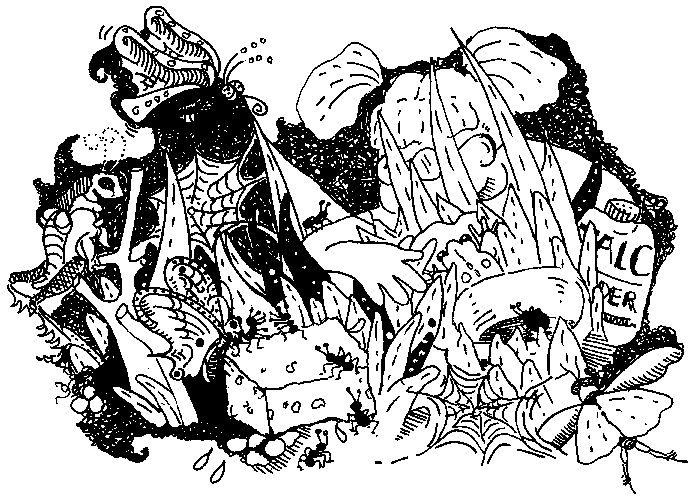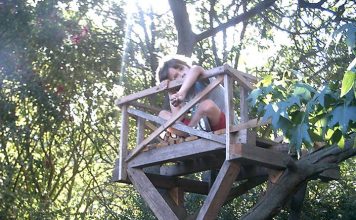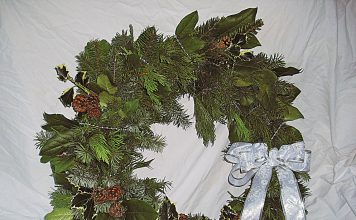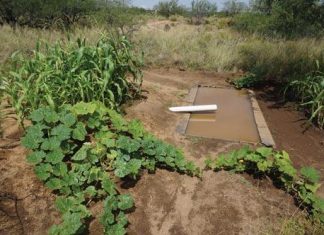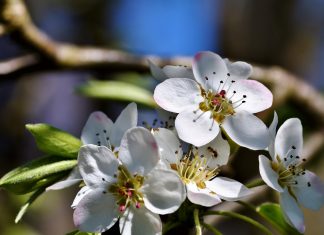| Issue #35 • September/October, 1995 |
Did you ever get an urge to just take off and go someplace exotic? Maybe the North Pole or the Amazon river basin? If you would care to take an adventure into the wild grasslands of North America, save this article! You can spend a morning on the dew-soaked plains, have several narrow escapes, share a snack with the local inhabitants, visit a real working commune, maybe even witness the mating dance of the elusive diptera conopidae AND be home in time for lunch! Are you ready? LET’S GO!

Click on the picture for a full-size, printable version, then color in this exotic grassland, and count its inhabitants.
Fill your backpack with the supplies that you’ll need (listed below), grab your hat, and hit the dirt! Yes, just open the back door, take a few steps and drop. The great grassy plains of your back yard will give you all the adventure that you can take for one day. If you imagine yourself knee-high to a grasshopper, and use a magnifying glass for special effects, a trip to the mailbox could become a breath-taking adventure! Just remember that you are a visitor to the world of the tiny lives you study. Leave their wilderness as you find it.
You will need:
- A plastic container with a top
- Honey or sugar and water
- An old clean sponge
- Some 4×5″ sheets of black construction paper
- Talcum powder
- A spray bottle filled with water
- Watered-down school glue
- Various sizes of thin boards
- A #10 can or coffee can or large wide-mouthed bottle
- A magnifying glass
- Some apples sliced into small shreds
A good explorer always brings gifts for the native inhabitants, so mix up a plastic container of honey or sugar water. Put the sponge into it, cap it, and save it for a quiet corner of the yard. When you find a good spot, place the wet sponge where you think that ants, bees, and diptera conopidae might find it. (In case you’ve not brushed up on your Latin lately, diptera conopidae is the scientific term for thick-headed fly…Yes, there really is such a thing!)
Leave it for about an hour, then quietly return to make a visitors list. Lie on your stomach and observe the sponge. Has the word spread yet about your gift? Notice tiny ant trails and use your magnifier to try and decipher their secret codes. Each time an ant passes a roommate, he rears up on his hind legs and chats in sign language. They play a sort of hand game, then give each other a ruffly hug. Some-times it’s messages being passed (kind of like our handshakes…friendly and important gestures), and sometimes they are simply sharing your gift of sweet nectar with each other.
If you shimmy down and really become a part of these grasslands, blending right into the lives of the animals, you might see how a butterfly visiting your sponge rolls down its long, straw-like proboscis to sip your sweet liquid gift. Have any bees lighted on your sponge? Notice the difference in how they take in the juice. A tiny shovel-like proboscis spoons the nectar into its hungry jaws.
Now take time to stretch your bones and wiggle around a bit. Are you ready to explore more deeply into these wilds? Watch carefully for the deadly lair of members of the order Arachnida. One false step, and you’re dead meat! (If you are an ant that is!) Since you are most likely human, you are in luck! Spider webs make a great study spot, and you can even take one home with you if you like. Take your watery glue, and paint it over one entire side of the construction paper. Carefully spritz the (vacant) web with water, then douse it with talcum. Bring the paper up under the web so that it sticks to the glued side. Now you have a beautiful piece of art work for your permanent collection!
Some of these prairie dwellers enjoy communal living. Place squares of plywood over spots that you’ve wet with your spray bottle. The wood will slow the water’s evaporation, and this dark, dank palace will attract all sorts of visitors! Check and re-squirt daily to keep the commune alive and thriving. Take note of who shows up to enjoy your hospitality.
Invite your new friends to “drop down for supper” by digging a small hole and inserting into it the #10 can. Drop the apple slices into the can and leave it overnight or for several days. You will be almost as surprised as your guests are when you see the wild variety of life that “bottoms out” at the #10 cafe. You might attract a whole food chain! Use your imagination if one morning your can comes up empty…Tiny bug falls into trap and is eaten by spider who is eaten by frog, who’s eaten by snake who’s eaten by bobcat who’s eaten by…wait a minute! You’d better get some neighborhood help before you check this trap!
These are just a few of the adventures that you can have while spending a day in the great plains of your own back yard. Keep a notebook to jot down your observations. Make up your own activities. Perhaps you will want to become a tour guide of this jumble of tiny life!


